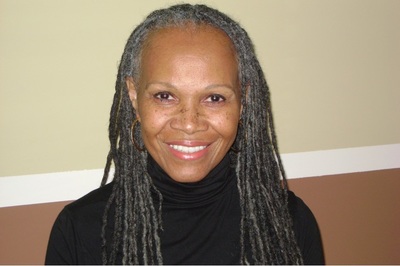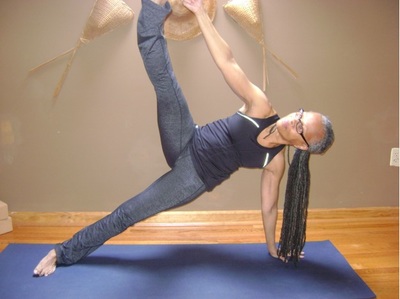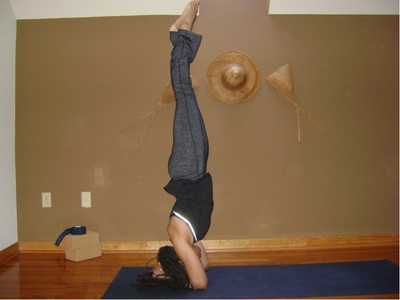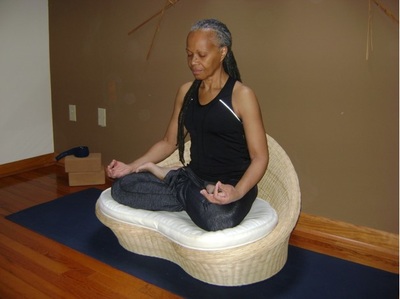|
March is a month of transition as we move from the season of vata to kapha. In Ayurveda the season of vata runs from fall to early winter and is dominated by the elements of air and space. During vata season we can expect dry cold and windy weather. The season of Kapha is dominated by earth and water and runs from late winter through spring. Wet, heavy and cool weather can be expected during kapha season. The increase of moisture in the atmosphere can be seen as the tipping point between the seasons. Although each season has two dominating elements one element is more dominate than the other. Air dominates the season of vata, while water is kapha's dominating element. All elements like to reside in certain areas of our bodies and when those elements increase in nature, they can also increase in our bodies. The colon is the main location for the air element, however it also likes to hang out in our joints, the area between the diaphragm and throat, the heart, head and small intestines. The main function of air is movement. Vata, which means "air" in Sanskrit, is responsible for all movement in our bodies. That includes, respiration, peristalsis, urination, excretion and birth and circulation of blood. An imbalance of air in the body can result variable digestion (Vishama Agni) leading to gas and constipation, stiffness in the joints, tremors, muscle spasms, loss of appetite and insomnia. The overall sense of excess lightness and instability can also lead to feelings of anxiety and mental spacyness. Water is mainly located in stomach, but also likes to reside in our oral cavity, plural cavity, respiratory tract, joints, and nervous system. In Sanskrit kapha means "to bind" and is responsible for all bodily fluids( i.e. plasma, urine, saliva, gastric secretions, sweat, synovial, lymph, semen), immunity, structure, growth and support. An imbalance of water in the body can lead, to edema, weight gain, respiratory issues, mucous, lethargy, and decrease in digestion (madna agni) leading to constipation. An excess of water can also lead to dullness in the mind resulting possessiveness and depression. During transitional times of the year it is important to become the constant observer of our minds and bodies to determine if there is an imbalance and what might be the cause. In Ayurveda a rule of thumb is that like increases like, so those who already have water or air in their mind/ body constitutions (doshas), may experience more symptoms of an imbalance than those who do not. For instance those with fire dominance (pitta) may be doing cart wheels this time of year. Once you've observed and discerned the imbalance the proper yoga asanas and pranayama can assist with in alleviating the imbalance. Vata (Air) The movement of the wind is erratic, so there can be excessive movement (i.e. tremors) or deficient movement (i.e. stiffness). An imbalance in air requires a calming and grounding approach, as well as warming the body and strength building. The end result of as satisfying practice should be a feeling of groundedness, calm and support. For those with an imbalance in the air element nadi shodhana (alternate nostril) pranayama, is a excellent choice to calm and balance the mind. Focusing on the retention of breath after inhale helps to create heat. Also during practice a deep even breath or ujjjayi pranayama adds heat to the body as well as focus and calm the mind is preferred. Asanas that help to ground the energy and move any stagnant air in the colon and lower abdomen while warming the body are best. The focus/ intent of the practice should be, strength, stillness, balance and grounding. The overall timing of the practice should be slow and mindful featuring long holds. Forward folds of all types help to contract the lower abdomen and colon helping to dispel gas and improve elimination. Standing poses connect us to the earth and move the energy downward (apana vayu), while strengthening the muscles. Twisting poses message the abdominal organs releasing tension. A long Savasana to balance vata should be (20 - 30 minutes), with the use of an eye pillow and blankets to provide a warm cocooning effect. The focus should be relaxing into stillness. Kapha (Water) The slow, heavy, cool and dense feeling of water can be felt in the upper or lower part of the body. The accumulation of water is usually felt in the upper body where mucus accumulates in the chest, throat, as well as the head and can cause congestion around the heart. Kapha in the lower body presents as fat deposits in the abdomen and thighs or water retention in the lower abdomen and legs. The binding qualities of Kapha can also lead to over-attachment resulting in lethargy/dullness in the body and mind. A Kapha balancing practice should result in reduction of mucus, water and body fat, as well as heat and strengthen the body. There should be a sense of lightness and renewed vigor as well as a feeling of detachment. A heat building pranayama like Kapalabhati or Bastrika, help to reduce congestion and mucous; increase lung capacity; oxygenate the blood and strengthen abdominal muscles. Focusing on the exhalation helps the energy to move upward (udana vayu). Using a deep ujjayi breath during practice heats breath, encourages full expansion of the lungs, and brings focus to the breath, calming the mind. Asanas that broaden and open the chest, increase stamina and strength as well as promote upward movement of energy are best. Backbends strengthen the back while stretching and opening the chest; promoting better breathing, reduction of mucous and congestion in the chest and upward movement of energy. Lateral asanas (i.e. virabhrdrasana ll and trikonasana) stretch the intercostal muscles between your ribs, and strengthens the diaphragm, abdomen, for better breathing. Twists not only massage the abdominal organs, but it also stokes digestive fire (jathara agni), heating stomach, helping to relieve congestion in the chest while improving digestion. Inversions; increase circulation providing more oxygen to the brain reducing dullness, allows lymph to more easily enter respiratory system, thereby boosting immune system, energizes the brain through increased blood flow and promotes upward movement of energy. The timing of the practice should be a vigorous pace, with long holds and repetition. Focus should be on strengthening, expansion, extending, and upward movement of energy. Unlike the cocooning effect for vata, kapha savasana can be done without props for 5 - 15 minutes with the focus n relaxing and releasing. Through observation and self study (svadhyaya), we can discern if water or air is causing a imbalance in our constitution and act accordingly. Once again pitta (fire) is more than likely enjoying some of the more invigorating activities that they cannot in warmer weather. But pitas should remember to stay dry, and avoid a chill; water and wind can dampen fire. Cool is good, but cold not so much. Motina Austin-Watson
1 Comment
Yolanda
3/9/2016 06:16:22 pm
You my friend are awesome!
Reply
Leave a Reply. |
Boundless Yoga Staff & StudentsWe are continuously interested on how our reactions and responses to our personal journeys, albeit travel, adventure, new job, etc. mirror and reflect our social, emotional and spiritual ups and downs. We try every day to apply what we learn about ourselves on the yoga mat to our personal lives. Thank you for tuning in as we share some of those aspects with you. Archives
December 2022
Categories
All
|
- HOME
-
- Monthly Challenge
- Book Club Discussion
- 7/11-8/1 (Thurs) Meditation & Mindful Movement Series
- 7/17 Beach Day Yoga Road Trip: Ocean Groove NJ
- 8/3- 8/28 (Tues): Roll & Release Series
- Sept/Oct: Inversion Immersion
- Sept-Dec: Personal Development Course
- 9/15 Moon Planning Workshop
- Bhakti Flow and Kirtan w/ Ian Froman
- Schedule
-
- 200 Hour Teacher Training
- 300 Hour Teacher Training
- Arm Balance Academy - CE Program
- Inversion Immersion Training Program
- Personal Development- Continuing Studies
- Thai Yoga Training
- The Boundless Breath ~ Pranayama Training Weekend
- The Koshas Demystified - Yoga Philosophy Course
- Rollit & Release it: Yoga and Fascia Continued Studies
- Yin Yoga Basics Course
- Yin Yoga Advanced Course
- Aerial Yoga Teacher Training
- Professional Development Continuing Studies Module
- Boundless Vinyasa Sequencing- Unlock the Power of Combination and Flow
- Aerial Yoga Yin-Restorative Training
- Graduate Directory
- Yoga Online Anytime
- Contact Us
- Blog: Insights from our Staff and Students
- Community Resources
- Studio Rental
- Media and News
- Yoga Podcast: Chats from the Mat w/ Brian M. Davis
- HOME
-
- Monthly Challenge
- Book Club Discussion
- 7/11-8/1 (Thurs) Meditation & Mindful Movement Series
- 7/17 Beach Day Yoga Road Trip: Ocean Groove NJ
- 8/3- 8/28 (Tues): Roll & Release Series
- Sept/Oct: Inversion Immersion
- Sept-Dec: Personal Development Course
- 9/15 Moon Planning Workshop
- Bhakti Flow and Kirtan w/ Ian Froman
- Schedule
-
- 200 Hour Teacher Training
- 300 Hour Teacher Training
- Arm Balance Academy - CE Program
- Inversion Immersion Training Program
- Personal Development- Continuing Studies
- Thai Yoga Training
- The Boundless Breath ~ Pranayama Training Weekend
- The Koshas Demystified - Yoga Philosophy Course
- Rollit & Release it: Yoga and Fascia Continued Studies
- Yin Yoga Basics Course
- Yin Yoga Advanced Course
- Aerial Yoga Teacher Training
- Professional Development Continuing Studies Module
- Boundless Vinyasa Sequencing- Unlock the Power of Combination and Flow
- Aerial Yoga Yin-Restorative Training
- Graduate Directory
- Yoga Online Anytime
- Contact Us
- Blog: Insights from our Staff and Students
- Community Resources
- Studio Rental
- Media and News
- Yoga Podcast: Chats from the Mat w/ Brian M. Davis
Get more updates and fun yoga information on our Facebook page!






 RSS Feed
RSS Feed